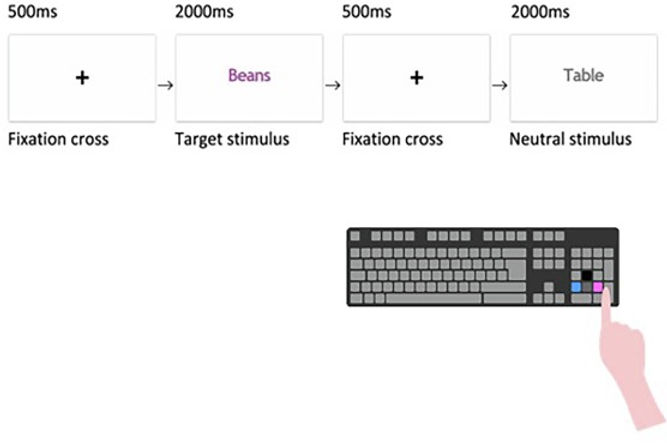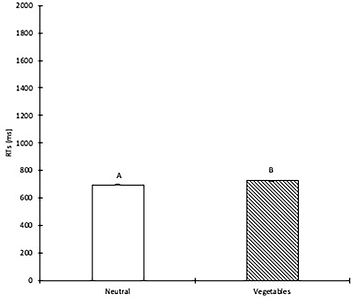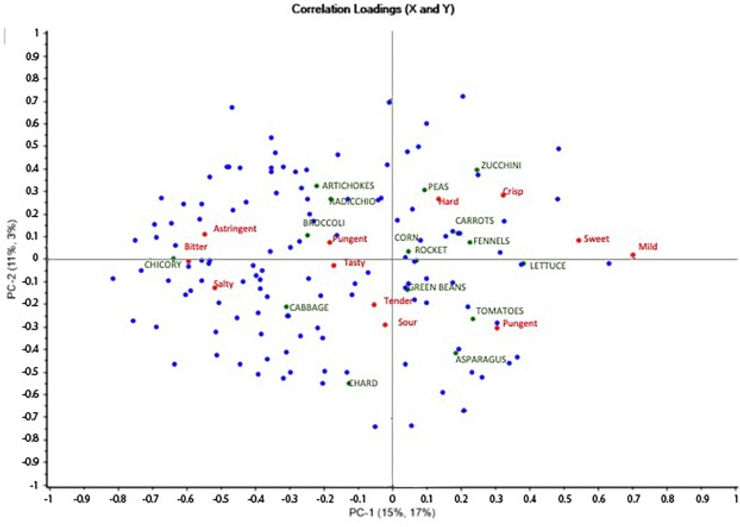
Attentional processes can influence vegetables acceptability
The importance and the health benefits provided from a high consumption of plant-based foods is well known. Indeed, various studies demonstrated the specific correlation between vegetables intakes and reduced presence of many diseases (for a review see Appleton et al., 2016). Although all the benefits, in the last decades a global dietary transition was registered with an increase of animal-based diet. Why people prefer one product over another one? Why healthy products are not consumed?
Within all the different variables that can interact between each other on the influence of food choice, attention may play a role in these processes.
Food cues are particularly effective at grabbing attention and may induce an attentional bias, that is defined as “the tendency for specific types of stimuli (e.g., food-related pictures and words) to capture and/or hold the attention” (Field et al., 2016, p. 768). According to the incentive-sensitization theory, an increased attention to food cues may be the result of repeated associations of reward from food intake and food cues that predict future caloric intake (Berridge, 2009). This would suggest that attentional bias may help to establish and maintain eating disorders and other forms of appetitive behaviors (Albery et al., 2020, Harrison et al., 2010, Schmitz et al., 2014). However, literature on obese populations and in general on eating-disorder patients, is contradictory, with some studies suggesting that obese and eating-disorders individuals report an increased attentional approach bias to food cues and others not, when compared to healthy-weight participants (Hagan et al., 2020, Hardman et al., 2021, Johansson et al., 2005, Werthmann et al., 2015).
Moreover, an attentional bias toward foods (both appetizing and less appetizing) was found also in normal-weight individuals, which it has been associated with hedonic motivation, but also to negative emotions, such as worry (Werthmann et al., 2015, Hardman et al., 2021).
Considering these aspects, a recent study of Agovi et al. (2022), investigated the role of attentional processes on 120 young adults (age range 20-24 y.o.; f= 74,2%), in order to understand if there is an attentional bias towards healthy foods (like vegetables) and how it can influence their acceptability.
There are different methodological approaches to measures attentional processes, one of the most known and widely used is the Emotional Stroop Task (Williams, Watts, Macleod, & Mathews, 1997), based on the assumption that the emotional salience of cues in the environment can affect attentional processes: attentional bias is here recorded as a difficulty on disengage the attention from the emotional salient stimuli.
Considering this introduction, a modified version of the Emotional Stroop Task was applied in the study of Agovi and colleagues: the target stimuli, thus those with “emotional salience”, have been represented by vegetables, compared to neutral stimuli (office objects).
It is important to consider that not all vegetables are rejected: there are some which are less accepted, in particular when they are characterized by critical sensory properties like bitterness, while sweet vegetables tend to be more consumed. For this reason, vegetables stimuli have been splitted in two categories: appealing (with positive sensory properties, like sweetness) and unappealing (with negative sensory properties, like bitterness and astringency).
Participants were asked to identify the color of the word (either vegetable or neutral object names) appearing on the computer screen by pressing the corresponding key on the keyboard (see on the picture below the example).

The test began with a fixation cross at the center of the screen (for 500 ms), which was presented also between each stimulus. Each word remained visible for 2000 ms; if the subject did not reply in time, the word disappeared, and no response was recorded. Attentional responses have been measured trough reaction times: longer reaction times (for vegetables or office objects) expressed higher attentional bias.
Moreover, since the selection of vegetables used as stimuli to measure attentional responses has been done a priori based on vegetables sensory properties, stated liking of the vegetables was assessed using a 9-point category scale (‘dislike extremely’/ ‘like extremely’) (Peryam & Pilgrim, 1957), to confirm the a priori grouping. Furthermore, a Check-all-That-Apply (CATA) questionnaire was also used to describe the sensory properties of each vegetable selected.
Results of this study showed that individuals reported an attentional bias towards vegetables: reaction time scores for vegetable cues were significantly longer than the ones in response to neutral objects. These results are consistent with Nijs et al. (2010) and Castellanos et al. (2009), which found longer reaction times for food-cues compared to neutral stimuli in normal-weight and overweight individuals. In this study only vegetables were used as food stimuli, while in the two studies above mentioned, the food target stimuli were represented by high-caloric food products (e.g. cake, pasta, kebab, chocolate, ice cream, etc…). The results of this study support the hypothesis that the food in itself, independently from the caloric content, elicits a greater attentional bias than non-food (neutral) stimuli.

In the picture mean and standard error of reaction times (RTs) to neutral stimuli (white bar) and to vegetable stimuli (filled bar) are reported. A,B Different letters indicate a significant difference between the groups (p < 0.05).
Authors also hypothesized that vegetables characterized by innately disliked sensory properties such as ‘bitterness’ and ‘astringency’ may be more disliked and possibly elicit more negative emotions, thus requiring more attention in their processing. The assumption was corroborated by the data, as the attentional bias for the unappealing vegetables was significantly greater than the one found for the appealing vegetables (more liked products). This means that when the word presented indicated a less liked vegetable, characterized by a less ‘sweet’ and ‘mild’ and more ‘bitter’ taste, for the participants it took more time to identify the color of the word. This indicates that vegetables characterized by unappealing sensory properties determine a greater attentional bias as compared to vegetables connoted by more appealing sensations. The finding was also supported by the strong by the significant inverse correlation between RTs and liking scores, that further highlights that sensory properties associated with less liked sensations, such as ‘bitter’, ‘astringent’ and ‘pungent’, were associated with a greater attentional bias compared to more innately liked sensations (such as ‘sweet’). In the picture, the Principal Component Regression (PCR) is reported. Subjects reaction times (blue); product coordinates (green) of reaction time (RT) data (X) and correlation loadings of frequencies of use of sensory descriptors (red) from the CATA test (Y).

This could reflect the delay to disengage the attention (Field and Cox, 2008, Pothos et al., 2009) from those vegetables connoted by warning sensations.
Finally, the authors did conclude that the results of the present study indicate, for the first time, that sensory properties (and liking) and not only the caloric content or the healthiness of a food product are able to induce an attentional bias. This means that specific sensory properties, innately aversive such as bitterness and astringency, may act as a concern-related environmental cue that grabs attention.
References
Albery, I. P., Michalska, M., Moss, A. C., & Spada, M. (2020). Selective attentional bias to food-related stimuli in healthy individuals with characteristics towards orthorexia nervosa. Eating and Weight Disorders, 25(5). https://doi.org/10.1007/s40519-019-00755-z
Appleton, K. M. K. M., Hemingway, A., Saulais, L., Dinnella, C., Monteleone, E., Depezay, L., Morizet, D., Armando Perez-Cueto, F. J. J., Bevan, A., & Hartwell, H. (2016). Increasing vegetable intakes: rationale and systematic review of published interventions. European Journal of Nutrition, 55(3). https://doi.org/10.1007/s00394-015-1130-8
Berridge, K. C. (2009). “Liking” and “wanting” food rewards: Brain substrates and roles in eating disorders. Physiology and Behavior, 97(5), 537–550. https://doi.org/10.1016/j.physbeh.2009.02.044
Castellanos, E. H., Charboneau, E., Dietrich, M. S., Park, S., Bradley, B. P., Mogg, K., & Cowan, R. L. (2009). Obese adults have visual attention bias for food cue images: Evidence for altered reward system function. International Journal of Obesity, 33(9) https://doi.org/10.1038/ijo.2009.138
Field, M., & Cox, W. M. (2008). Attentional bias in addictive behaviors: A review of its development, causes, and consequences. In Drug and Alcohol Dependence, 97(1-2). https://doi.org/10.1016/j.drugalcdep.2008.03.030
Field, M., Werthmann, J., Franken, I., Hofmann, W., Hogarth, L., & Roefs, A. (2016). The role of attentional bias in obesity and addiction. In Health psychology : official journal of the Division of Health Psychology, American Psychological Association 35(8). https://doi.org/10.1037/hea0000405
Hagan, K. E., Alasmar, A., Exum, A., Chinn, B., & Forbush, K. T. (2020). A systematic review and meta-analysis of attentional bias toward food in individuals with overweight and obesity. In Appetite, 151. https://doi.org/10.1016/j.appet.2020.104710
Hardman, C. A., Jones, A., Burton, S., Duckworth, J. J., McGale, L. S., Mead, B. R., Roberts, C. A., Field, M., & Werthmann, J. (2021). Food-related attentional bias and its associations with appetitive motivation and body weight: A systematic review and meta-analysis. In Appetite, 157. https://doi.org/10.1016/j.appet.2020.104986
Johansson, L., Ghaderi, A., & Andersson, G. (2005). Stroop interference for food- and body-related words: A meta-analysis. Eating Behaviors, 6(3). https://doi.org/10.1016/j.eatbeh.2004.11.001
Nijs, I. M. T., Franken, I. H. A., & Muris, P. (2010). Food-related Stroop interference in obese and normal-weight individuals: Behavioral and electrophysiological indices. Eating Behaviors, 11(4). https://doi.org/10.1016/j.eatbeh.2010.07.00
Peryam, D. R., & Pilgrim, F. J. (1957). Hedonic scale method of measuring food preferences. In Food Technology.
Pothos, E. M., Calitri, R., Tapper, K., Brunstrom, J. M., & Rogers, P. J. (2009). Comparing measures of cognitive bias relating to eating behaviour. Applied Cognitive Psychology, 23(7). https://doi.org/10.1002/acp.1506
Werthmann, J., Jansen, A., & Roefs, A. (2015). Worry or craving? A selective review of evidence for food-related attention biases in obese individuals, eating-disorder patients, restrained eaters and healthy samples. Proceedings of the Nutrition Society, 74(2). https://doi.org/10.1017/S0029665114001451
Williams, J., Watts, F., Macleod, C., & Mathews, A. (1997). Cognitive Psychology and Emotional Disorders Second Edition. In Wiley


